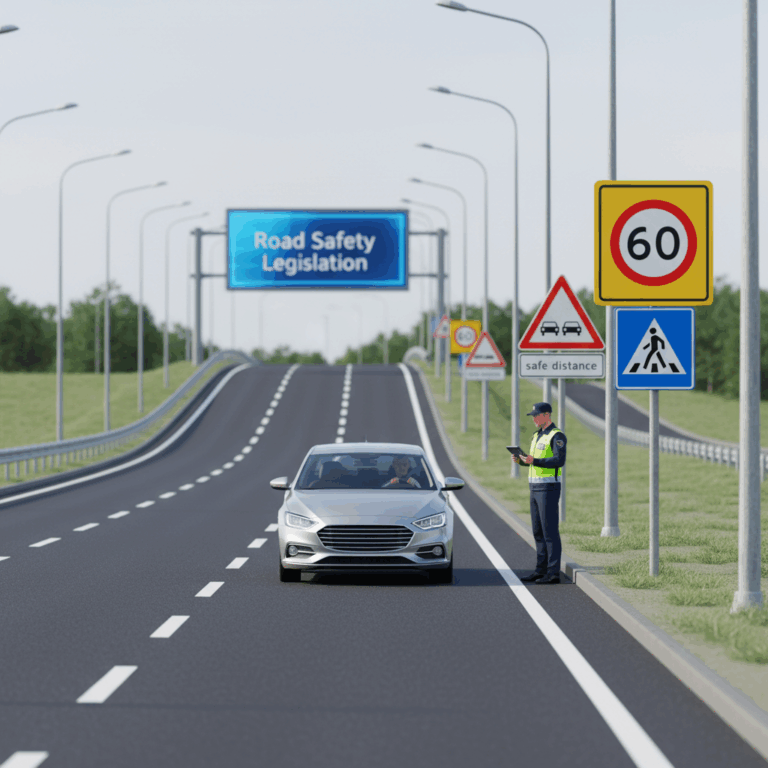Key Changes in Road Safety Laws for 2025
The road safety laws for 2025 introduce significant amendments aimed at enhancing protection for all road users and adapting to modern mobility trends. These changes reflect a strong commitment to safer driving across Spain.
Among the most notable updates is the stricter blood alcohol limit and reinforced requirements for motorcyclists, ensuring that drivers meet new standards and comply with safety regulations effectively.
These modifications are vital for reducing accidents and promoting responsible behavior on the roads, aligning legislation with current mobility needs.
Lower Blood Alcohol Limit and Stricter Penalties
The permitted blood alcohol limit will be reduced from 0.5 g/l to 0.2 g/l, significantly lowering tolerance levels for drivers. This change aims to deter driving under the influence and improve overall road safety.
Stricter penalties accompany this reduction, encouraging responsible alcohol consumption and reducing accident risks linked to impaired driving. Fines and sanctions will be more severe for offenders.
These measures promote a culture of caution, emphasizing that driving requires full attention and sobriety at all times to protect lives.
New Requirements for Motorcyclists
Motorcyclists will face new obligations, including the mandatory use of a full-face helmet and approved gloves to enhance personal safety during rides. These requirements aim to reduce severe injuries in accidents.
Additionally, motorcyclists will be allowed to use the shoulder during congested traffic at speeds up to 30 km/h, helping ease traffic flow while maintaining safety standards.
Drivers holding a category B license will need to complete specific courses before riding motorcycles up to 125 cc, ensuring proper knowledge and skill for safe motorcycle operation.
Updates to Vehicle Insurance and Legal Protection
The 2025 road safety legislation modernizes mandatory vehicle insurance to better cover emerging transportation types. This update reflects adaptations to evolving mobility trends in Spain.
Enhanced legal protection measures for accident victims are introduced, strengthening civil liability provisions and improving insurer oversight for greater claimant security.
Coverage extends to light personal vehicles, recognizing their growing use and ensuring users receive appropriate insurance and legal safeguards on the road.
Modernization of Mandatory Vehicle Insurance
The insurance system now includes light personal vehicles such as electric scooters and small motorbikes, reflecting new mobility patterns. This modernization ensures all users have basic coverage.
The law enhances solvency and supervision of insurers, requiring stricter financial and operational standards to protect policyholders and accident victims effectively.
This shift aligns insurance policies with contemporary traffic realities, increasing reliability and response capacity after incidents involving emerging types of vehicles.
Enhanced Legal Protection for Accident Victims
New provisions bolster civil liability rules, ensuring victims receive fairer compensation for damages caused by traffic accidents. This reform prioritizes victim rights and justice.
Legal frameworks now impose more rigorous obligations on insurers, improving accountability and speeding up claims processing to support injured parties promptly.
By reinforcing legal protection, the legislation fosters confidence among road users, encouraging safer driving behaviors and respect for traffic regulations.
Expanded Coverage for Light Personal Vehicles
The law officially brings light personal vehicles under the umbrella of mandatory insurance, addressing a gap in previous regulations. This includes electric scooters and similar devices.
Users of these vehicles will now benefit from legal and financial protection against accidents, aligning their coverage closer to traditional motor vehicles.
This expansion aids in managing risks associated with increasing urban micro-mobility, promoting responsible usage and safety awareness among new road participants.
Revisions in Traffic Regulations and Signage
The 2025 traffic regulations introduce crucial updates to improve road safety and better accommodate modern transportation modes. These revisions reflect a comprehensive effort to adapt laws to current mobility needs.
New signage and emergency protocols will enhance driver awareness and ensure quicker responses to incidents, contributing to safer, more efficient roadways for all users.
Restrictions in hazardous conditions and emission zones emphasize protection of vulnerable road users and environmental sustainability as part of the updated framework.
Introduction of New Traffic Signs and Emergency Lanes
The updated regulations add around 90 new traffic signs, designed to address the challenges posed by electric and active mobility. These signs promote clearer communication of rules and warnings.
Emergency lanes must now be created during traffic jams, allowing urgent vehicles to pass swiftly. This obligation is essential for saving lives and minimizing emergency response times.
These measures improve road order and safety significantly, especially in congested traffic, by ensuring that drivers understand new signals and facilitate emergency access effectively.
Restrictions in Hazardous Conditions and Low Emission Zones
The laws prohibit overtaking on roads under icy or snowy conditions and require vehicles to stay in the right lane during such hazards, prioritizing driver safety under adverse weather.
Stricter regulations are enforced in low emission zones, limiting access and imposing tighter penalties for violations. This contributes to pollution reduction and healthier urban environments.
Such restrictions also reinforce compliance among electric scooters and similar light personal vehicles, further aligning traffic control with sustainable mobility goals.
Implications for Drivers and Road Safety
The 2025 road safety laws place new responsibilities on drivers to ensure full compliance with updated regulations. Understanding these changes is crucial for avoiding penalties and enhancing overall safety on the roads.
Drivers must adapt to stricter alcohol limits, updated vehicle requirements, and new traffic rules. Staying informed helps maintain lawful conduct and promotes safer driving practices for everyone.
These legislative adjustments aim not only to enforce compliance but also to foster a culture of responsibility and awareness among all road users, reducing accidents and injuries.
Impact on Driver Responsibilities and Compliance
Drivers are now required to respect a lower blood alcohol limit of 0.2 g/l, demanding greater awareness and self-control regarding alcohol consumption before driving.
Additionally, motorcyclists must comply with new equipment rules and behavior standards, while all drivers should be familiar with updated traffic signs and emergency lane protocols.
Compliance with these rules is critical to avoid fines and contribute to a safer road environment. Drivers need to stay updated and actively follow the new regulations.
By embracing these obligations, drivers help create a safer traffic culture that benefits all road users, including vulnerable groups like pedestrians and cyclists.
Contribution to Safer and More Sustainable Mobility
The reforms encourage safer driving habits and aim to reduce road accidents, contributing directly to improved public safety across urban and rural areas.
By regulating light personal vehicles and promoting legal protection, the laws support sustainable and inclusive mobility options, integrating new transport methods responsibly.
These measures advance environmental goals by limiting emissions in designated zones and promoting compliance with traffic rules designed for modern, eco-friendly transportation.
Interesting Fact
Implementing emergency lanes for rescue vehicles during traffic jams saves critical time for emergency response, potentially lowering fatality rates in accidents and medical emergencies.
This innovation reflects a practical and life-saving approach in the new regulations, emphasizing swift aid as part of comprehensive road safety strategies.







